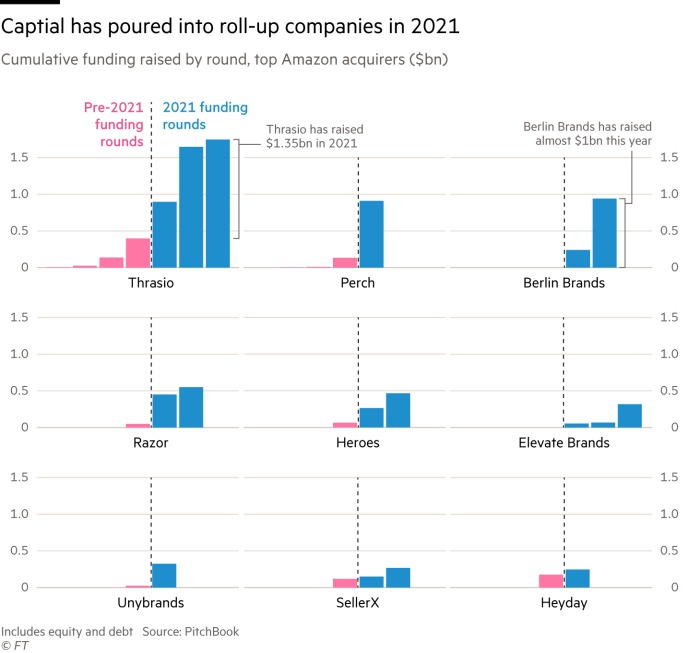Amazon ‘roll-up’ businesses raise billions in fight for ascendancy
As Covid-19 lockdowns propelled record ecommerce growth in the final months of 2020, a new kind of online retailer began to attract investors.
A handful of ecommerce “aggregators”, led by Massachusetts-based Thrasio, had together raised $1bn by the end of the year to buy up the most successful independent merchants on Amazon’s marketplace.
That was when a billion dollars seemed like a lot of money. But just nine months later, dozens of lookalike Amazon “roll-up” businesses have now raised a more than $8bn to date between them, according to Marketplace Pulse, which tracks the sector.
Just this week, three Amazon-focused companies in Europe announced they had raised a combined $1bn in a single day. That included $700m in debt and equity for Berlin Brands Group in a deal led by Bain Capital, valuing the German company at more than $1bn.
“Everyone is asking themselves if there is enough space for so much money. The short reply is yes,” said Peter Chaljawski, BBG’s founder and chief executive. “We see that our inbound and funnel [of potential merchant acquisitions] is extremely full.”

Out of the millions of sellers who have set up virtual shop on Amazon’s marketplace, acquirers see tens of thousands with buyout potential: making profitable products with plenty of five-star reviews that sell more than $1m a year.
Even obscure niches, from sex toys to doorstops, can become big businesses on a platform estimated by Marketplace Pulse to generate $300bn in sales last year.
2020 was an unusual year for anyone selling anything online. Some of Amazon’s largest markets, such as the US, UK and Germany, have reopened their high streets after lockdowns, sending shoppers back into physical stores. According to Fable Data, which tracks credit card transactions, UK online retail spend is down about 40 percentage points since non-essential shops were allowed to reopen on April 12. This compares with an increase in spend of 45 percentage points for physical stores over the same period.
“At the start of the year, everyone had had their best year ever,” said Taliesen Hollywood, director at Hahnbeck, a boutique M&A consultancy focused on ecommerce deals. “Now, people are not shopping online quite as much and the growth is nowhere near as strong.”
That has helped to stabilise the prices that acquirers are paying for sellers, despite the fire hose of cash coming into the sector. After being “desperate for deal flow” at the beginning of 2021, the aggregators are “becoming more selective and saying no to a lot more deals”, said Hollywood.

Amazon marketplace businesses are usually valued on a multiple of “seller’s discretionary earnings”, which adjusts a more standardised measure of profitability — earnings before interest, tax, depreciation and amortisation — for certain costs such as marketing, legal and salaries that the acquiring company expects to operate in-house. During the past few months, merchants have typically sold for around four to five times SDE.
“Multiples have gone up, but they are still at levels where it makes sense,” said Philipp Triebel, co-founder of SellerX, another Berlin-based Amazon aggregator that raised €100m in new equity last month. “You don’t see the same growth as you saw last year, but nobody would bet against ecommerce as a sector.”
Some product categories, such as home fitness or gardening gear, have suffered more this year than others, but aggregators with a range of merchants in their portfolio believe they can ride out the highs and lows.
“We buy businesses for certain multiples and our business gets valued at a significantly higher valuation because of the synergies and the diversification,” said Riccardo Bruni, co-founder of Heroes, a UK-based aggregator which raised $200m this week.

The hope is that after they have acquired several such businesses, applied efficiencies to their supply chain or marketing and expanded into new markets, the collection of merchants will be worth more than the sum of its parts.
For instance, Bruni said Heroes was able to reduce the price per unit for one of its acquired merchants from $7 to $5.50 within days of closing the deal, thanks to its supply-chain connections in China.
Still, many of the companies operating in this sector are barely a year old, meaning few have established a record that proves they can reliably execute on that blueprint for efficiency and synergy.
In the short term, that makes it more expensive for them to finance their acquisition sprees. These aggregator start-ups have turned to debt to raise such large sums quickly by tapping lenders, rather than the venture capitalists who usually provide equity financing to young tech companies.
“The reason we have access to debt capital and you see all these big fund raises is ultimately we are buying profitable businesses,” said Giancarlo Bruni, who co-founded Heroes alongside his brothers Riccardo and Alessio. Compared to his previous role in corporate finance at telecoms consolidator Liberty Global, Heroes has to pay “significantly higher interest”, he added.
Nonetheless, Amazon’s marketplace is industrialising almost as fast as the roll-up outfits can raise capital. Dozens of specialist brokers have emerged in the past year to help merchants find a buyer, as well as a small army of trademark lawyers, accountants and other advisers.
“Over the past few months the [M&A] process has matured,” said Ollie Horbye, co-founder of Olsam, another UK-based aggregator which raised $165m this week.
“Being public with our funding gives sellers we have never met before more confidence in Olsam and our ability to close [a deal],” said Horbye. “There are a long tail of acquirers in this space. The deal flow does concentrate towards the more well-known, bigger players.”